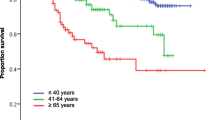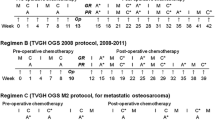Abstract
The aim of this retrospective, multicenter study was to evaluate clinicopathological characteristics, prognostic factors and treatment outcomes of teenage and adult patients with high-grade osteosarcoma. A total of 240 osteosarcoma patients who were diagnosed and treated from March 1995 to September 2011 were analyzed. Median age was 20 years (range 13–74 years), and 153 patients (63.8 %) were male. Primary tumor localization was extremity in 204 patients (85.4 %), trunk in 21 patients (8.8 %) and head and neck region in 14 patients (5.9 %). According to American Joint Committee on Cancer staging system, 186 patients (77.5 %) were stage II, 3 (1.3 %) were stage III and 48 (20.0 %) were stage IV. Median overall survival (OS) was 55 months (95 % CI 36.8–73.1 months). OS after 2, 5 and 10 years were 67, 49 and 42 %, respectively. Univariable analysis for OS showed that male gender (p = 0.032), high baseline lactate dehydrogenase (LDH) level (p < 0.001), high baseline serum alkaline phosphatase level (p = 0.002), telangiectatic subtype (p = 0.023), presence of metastasis at diagnosis (p < 0.001), presence of tumor positive margins after primary surgery (p = 0.015), poor pathological response to preoperative chemotherapy (p = 0.006) and presence of recurrent disease during follow-up period (p < 0.001) were significantly associated with poor survival. Patients who received postoperative methotrexate plus doxorubicin plus cisplatin (M + A + P) combination regimen (p = 0.019), underwent surgery for recurrent disease (p < 0.001) and received chemotherapy for recurrent disease (p < 0.001) had longer OS. In multivariable analysis for OS, only high LDH level (p = 0.002) and the presence of metastasis at diagnosis (p = 0.011) were associated with poor OS, whereas the patients who received chemotherapy for recurrent disease had a longer OS (p = 0.009).



Similar content being viewed by others
References
Mirabello L, Troisi RJ, Savage S. Osteosarcoma incidence and survival rates from 1973 to 2004: data from the surveillance, epidemiology, and end results program. Cancer. 2009;115(7):1531–43.
Ritter J, Bielack SS. Osteosarcoma. Ann Oncol 2010;21(Suppl 7):vii320–5.
Meyers PA, Heler G, Healey JH, et al. Osteogenicsarcoma with clinically detectable metastasisatinitial presentation. J Clin Oncol. 1993;11:449–53.
Friedman MA, Carter SK. The therapy of osteogenic sarcoma: current status and thoughts for the future. J Surg Oncol. 1972;4:482–510.
Hogendoorn PC; ESMO/EUROBONET Working Group. Bone sarcomas: ESMO clinical practice guidelines for diagnosis, treatment and follow-up. Ann Oncol. 2010;21(Suppl 5):v204–13.
Pastorino U, Buyse M, Friedel G, et al. Long-term results of lung metastasectomy: prognostic analyses based on 5206 cases. The international registry of lung metastases. J Thorac Cardiovasc Surg. 1997;113(1):37–49.
Heck RK Jr, Stacy GS, Flaherty MJ, Montag AG, Peabody TD, Simon MA. A comparison study of staging systems for bone sarcomas. Clin Orthop Relat Res. 2003;415:64–71.
Bielack SS, Kempf-Bielack B, Delling G, et al. Prognostic factors in high grade osteosarcoma of the extremities or trunk: an analysis of 1,702 patients treated on neoadjuvant cooperative osteosarcoma study group protocols. J Clin Oncol. 2002;20:776–90.
Kim MS, Lee SY, Lee TR, et al. Prognostic nomogram for predicting the 5-year probability of developing metastasis after neo-adjuvant chemotherapy and definitive surgery for AJCC stage II extremity osteosarcoma. Ann Oncol. 2009;20(5):955–60.
Kong CB, Song WS, Cho WH, Oh JM, Jeon DG. Local recurrence has only a small effect on survival in high-risk extremity osteosarcoma. Clin Orthop Relat Res. 2012;470(5):1482–90.
Davis AM, Bell RS, Goodwin PJ. Prognostic factors in osteosarcoma: a critical review. J Clin Oncol. 1994;12(2):423–31.
Bacci G, Ferrari S, Mercuri M, et al. Predictive factors for local recurrence in osteosarcoma: 540 patients with extremity tumors followed for minimum 2.5 years after neoadjuvant chemotherapy. Acta Orthop Scand. 1998;69(3):230–6.
Janeway KA, Barkauskas DA, Krailo MD, et al. Outcome for adolescent and young adult patients with osteosarcoma: a report from the children’s oncology group. Cancer. 2012;118(18):4597–605.
Song WS, Kong CB, Jeon DG, et al. Prognosis of extremity osteosarcoma in patients aged 40–60 years: a cohort/case controlled study at a single institute. Eur J Surg Oncol. 2010;36:483–8.
Harting MT, Lally KP, Andrassy RJ, et al. Age as a prognostic factor for patients with osteosarcoma. An analysis of 438 patients. J Cancer Res Clin Oncol. 2010;136:561–70.
Bramer JA, Abudu AA, Tillman RM, Carter SR, Sumathi VP, Grimer RJ. Pre- and post-chemotherapy alkaline phosphatase levels as prognostic indicators in adults with localised osteosarcoma. Eur J Cancer. 2005;41(18):2846–52.
Ferrari S, Bacci G, Picci P, et al. Long-term follow-up and post-relapse survival in patients with non-metastatic osteosarcoma of the extremity treated with neoadjuvant chemotherapy. Ann Oncol. 1997;8(8):765–71.
Osaka E, Suzuki T, Osaka S, et al. Survivin as a prognostic factor for osteosarcoma patients. Acta Histochem Cytochem. 2006;39(3):95–100.
Khanna C, Wan X, Bose S, et al. The membrane-cytoskeleton linker ezrin is necessary for osteosarcoma metastasis. Nat Med. 2004;10(2):182–6.
Edge SB, Byrd DR, Compton CC, et al. AJCC cancer staging manual. New York: Springer; 2010.
Picci P, Bacci G, Campanacci M, et al. Histologic evaluation of necrosis in osteosarcoma induced by chemotherapy. Regional mapping of viable and nonviable tumor. Cancer. 1985;56(7):1515–21.
Min D, Lin F, Shen Z, et al. Analysis of prognostic factors in 333 Chinese patients with high-grade osteosarcoma treated by multidisciplinary combined therapy. Asia Pac J Clin Oncol. 2013;9(1):71–9.
Mendenhall WM, Fernandes R, Werning JW, Vaysberg M, Malyapa RS, Mendenhall NP. Head and neck osteosarcoma. Am J Otolaryngol. 2011;32(6):597–600.
Junior AT, de Alves FA, Pinto CA, Carvalho AL, Kowalski LP, Lopes MA. Clinicopathological and immunohistochemical analysis of twenty-five head and neck osteosarcomas. Oral Oncol. 2003;39(5):521–30.
Fernandes R, Nikitakis NG, Pazoki A, Ord RA. Osteogenic sarcoma of the jaw: a 10-year experience. J Oral Maxillofac Surg. 2007;65(7):1286–91.
Whelan JS, Jinks RC, McTiernan A, et al. Survival from high-grade localised extremity osteosarcoma: combined results and prognostic factors from three European Osteosarcoma Intergroup randomised controlled trials. Ann Oncol. 2012;23(6):1607–16.
Matsuno T, Unni KK, McLeod RA, Dahlin DC. Telangiectatic osteogenic sarcoma. Cancer. 1976;38(6):2538–47.
Sangle NA, Layfield LJ. Telangiectatic osteosarcoma. Arch Pathol Lab Med. 2012;136(5):572–6.
Cho WH, Song WS, Jeon DG, et al. Differential presentations, clinical courses, and survivals of osteosarcomas of the proximal humerus over other extremity locations. Ann Surg Oncol. 2010;17(3):702–8.
Anninga JK, Gelderblom H, Fiocco M, et al. Chemotherapeutic adjuvant treatment for osteosarcoma: where do we stand. Eur J Cancer. 2011;47(16):2431–45.
Tabone MD, Kalifa C, Rodary C, Raquin M, Valteau-Couanet D, Lemerle J. Osteosarcoma recurrences in pediatric patients previously treated with intensive chemotherapy. J Clin Oncol. 1994;12(12):2614–20.
Saeter G, Hoie J, Stenwig AE, Johansson AK, Hannisdal E, Solheim OP. Systemic relapse of patients with osteogenic sarcoma. Prognostic factors for long term survival. Cancer. 1995;75(5):1084–93.
Errani C, Longhi A, Rossi G, et al. Palliative therapy for osteosarcoma. Expert Rev Anticancer Ther. 2011;11(2):217–27.
Bielack SS, Kempf-Bielack B, Branscheid D, et al. Second and subsequent recurrences of osteosarcoma: presentation, treatment, and outcomes of 249 consecutive cooperative osteosarcoma study group patients. J Clin Oncol. 2009;27(4):557–65.
Conflict of interest
The authors have declared no conflicts of interest.
Author information
Authors and Affiliations
Corresponding author
Additional information
This study was conducted on behalf of Anatolian Society of Medical Oncology (ASMO).
Rights and permissions
About this article
Cite this article
Durnali, A., Alkis, N., Cangur, S. et al. Prognostic factors for teenage and adult patients with high-grade osteosarcoma: an analysis of 240 patients. Med Oncol 30, 624 (2013). https://doi.org/10.1007/s12032-013-0624-6
Received:
Accepted:
Published:
DOI: https://doi.org/10.1007/s12032-013-0624-6




